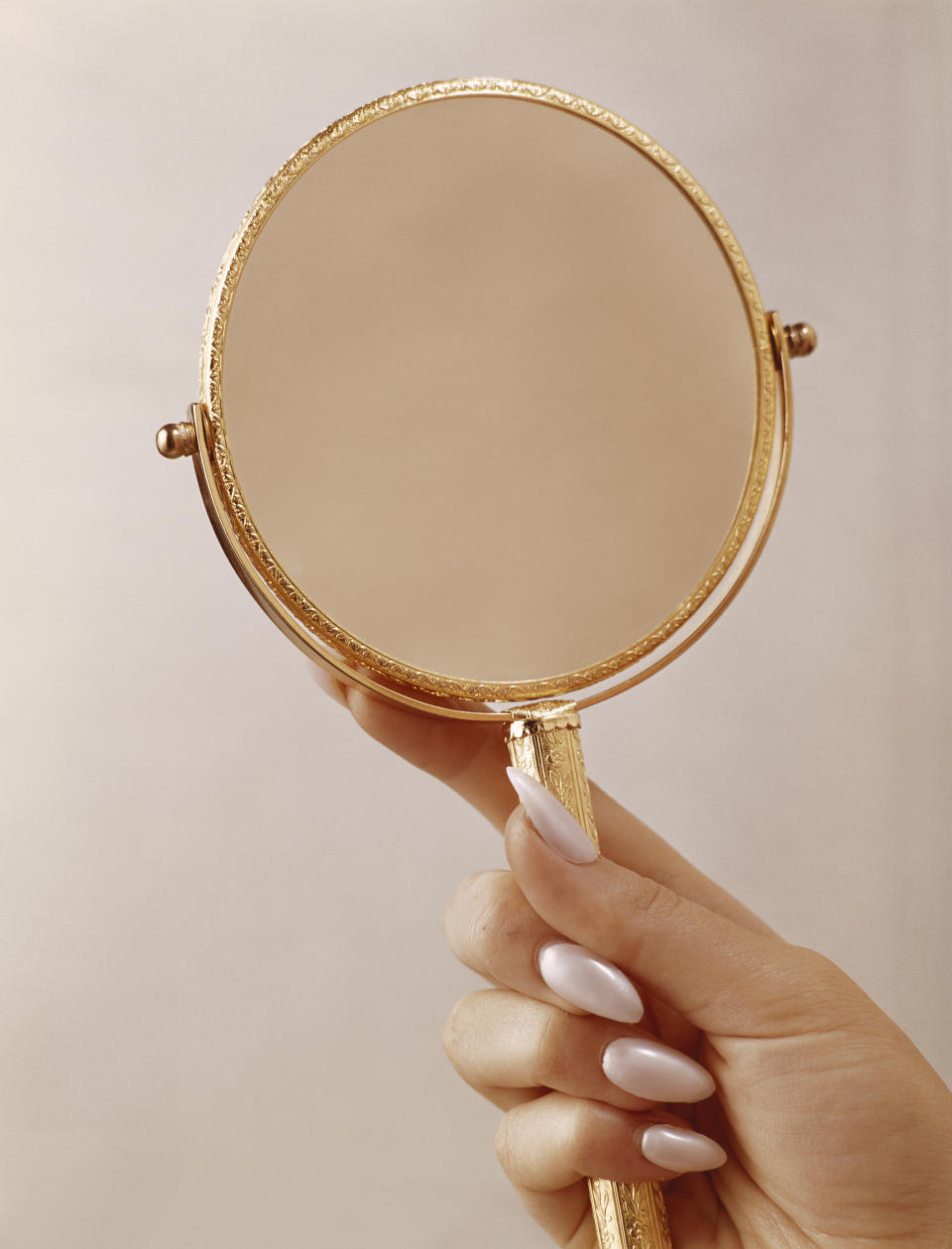"I Had No Idea": This Doctor's PSA About Health And Hygiene Is Vital For Anyone With A Vagina

It feels like every week, I learn some new (and often at least mildly terrifying) information about the way my body works. Well, this week is no different. We're gathered here today to talk about clitoral adhesions: a phenomenon where your clitoris can actually get stuck under the hood.
I discovered this unsettling info thanks to a Reddit thread titled, "PSA: lift your clit hood all the way back to clean, or you could end up with it fused to your clit."
The poster wrote, "It’s thought that about 20-25% of women may have clitoral adhesions (hood partially or fully fused to clit), many without symptoms (or without noticing symptoms at first, as some report better orgasms after treating the adhesions). I’m a 33-year-old woman who has great hygiene and was raised by a nurse practitioner. If I didn’t know how to properly clean under my clit hood, I’m confident many in this group might not either."

"I’ve always used my fingers to spread the tissue to rinse thoroughly but I was never taught to pull the hood back every shower to rinse underneath. I found myself reading about adhesions not too long ago, and I was shocked to discover upon further inspection that my hood is fused to my clit, and I had no idea. It’s now been over a month of cleaning it properly, and I’ve seen about a 4mm reduction in the adhesion.
I just wanted to put this out there, even if it just helps one person, because my mind is blown over this. I had no ‘symptoms,’ sex has been totally normal for me. I truly don’t know how long it’s even been like this, as I realize I was never even educated properly on clitoral anatomy, only every other part of my anatomy."
One commenter summed up my feelings perfectly when they replied, "The human body is an absolute mess that is the biological equivalent of being held together by tape, hope, and not knocking a table."
Many commenters expressed that they had absolutely no idea this could even happen, with one person writing, "I have a foreskin?"
Another person wrote, "I always thought I had a microscopic clit, but now I’m wondering if I have clitoral adhesion..."
Another commenter shared their personal experience with a clitoral adhesion: "I have one due to a previous injury that I have to have surgically removed periodically (nothing I do keeps this sucker from reforming, and believe me, I’ve tried). It reduces arousal a bit and can also become painful when the area rubs against something like the seam in pants, etc."

"In appearance, it’s like a hard but kinda of squishy little white ball and doesn’t have to be that big to start hurting. I can’t even see mine with a mirror because the skin covers it and won’t pull back, but I can’t feel when it’s a problem. To remove it, they give injections around the area to numb it and pick/cut it out of there. It leaves the skin very raw but heals up within a day or two."
I had to learn more, so I reached out to Dr. Rachel Rubin. Dr. Rubin is a board-certified urologist and sexual medicine specialist and one of the authors of a study on clitoral adhesions. She kindly sat down for a call with me, and it was truly eye-opening.
Dr. Rubin explained that in her background in urology, it has long been a common practice to teach uncircumcised boys to pull back their foreskin and clean underneath it to prevent a very similar issue called phimosis. "Because if they don't do that, they can get something called phimosis which is when the hood is stuck to the head of the penis and when your foreskin gets stuck to the head of your penis. When you get erections and it moves and stretches, it doesn't feel so good. It hurts. It's restricted. It's not comfortable."

"And so every pediatrician, urologist, and primary care doctor knows what phimosis is, they know how to treat it, and we typically treat it with stretching maneuvers and sometimes topical steroids. If it gets so bad, it can lead to circumcision in early childhood or early adulthood. And this is something where every sort of doctor who takes care of men knows what to do."
Dr. Rubin went on to explain that the clitoris is actually extremely similar to the penis, but it hasn't been studied nearly as much. "The clitoris is exactly the same thing in every way, shape, and form. It's just that we don't pee through or penetrate with our clitorises, so science has completely abandoned hearing about them."
She continued, saying, "All of the parts of the clitoris have analogous structures to the penis and are made of the same tissues, the same muscle, the same nerves and so clitorises have hoods, they have foreskins, prepuce is another word for it. And we have no research about what to do [for clitoral adhesions]."
Since the clitoris has been so understudied, Dr. Rubin's research started with simply establishing how common clitoral adhesions are by looking at the clitorises of patients who were being treated for sexual concerns. "We looked at thousands of vulva pictures, and we found about 22% or 23% of all women have some degree of clitoral adhesion: mild, moderate, or severe." Later, a similar study done in college students found a similar number of clitoral adhesions.
She said, "Mild means you can see most of the head of the clitoris but not the whole thing because the sides get kind of stuck to the hood. Moderate means you can see a little bit of a head, but it's pretty covered over, and severe is like you really can't see any of the head of the clitoris. It's totally covered over with the hood."
Dr. Rubin has sample photos of clitoral adhesions ranging from mild to severe on her website, if it helps to have a visual aid. Note that the images are NSFW, for obvious reasons.
People with clitoral adhesions reported various symptoms. Some people had diminished sensitivity in their clitoris, while others reported pain or even constant and unwanted feelings of arousal. For some, the clitoral adhesion felt similar to having sand under their eyelid (but, you know, down there), while others didn't have any symptoms at all.

There's not enough research yet into what causes clitoral adhesions, but Dr. Rubin has a few hypotheses. She says it's possible that there's a hormonal component, as changes in testosterone levels during menopause or while taking birth control pills could affect the clitoris. Clitoral adhesions may also be linked to other conditions that cause dryness or inflammation in the genital area.
Dr. Rubin says that her clinic treats clitoral adhesions by gently stretching the hood back while the area is numbed. "We're not cutting anything; we're not sewing anything... There are a lot of nerves that belong in there, and there's definitely a significant risk of damaging nerves if you're going to be cutting anything in that area. So you really want to work with someone who has a deep understanding of the anatomy, but also really trying to do the most minimally invasive thing possible, because you don't want to make anything worse."
Unfortunately, gynecologists don't routinely look at the clitoris during a pelvic exam, and most don't know how to treat clitoral adhesions. If you suspect that you have a clitoral adhesion and you'd like to get medical care, Dr. Rubin recommends looking on the International Society for the Study of Women's Sexual Health website (ISSWSH.org) to find a more informed provider in your area.
If you've never really looked at your clitoris, Dr. Rubin hopes you'll at least take a peak. "I think, at the very least, people should grab a mirror and start looking down there and explore. The head of a clitoris should look like the head of the penis that has a rim around it like a mushroom, right? That is called a corona."

"Can you see here the whole head of your clitoris? Can you see the corona, because your doctor has never looked for it. Doctors are not trained or taught how to do this exam. Which again, can you imagine if I was taught not to do a penis exam as a urologist?"
After her initial study, a group of medical students working under Dr. Rubin looked into how patients felt after their clitoral adhesions had been treated. Dr. Rubin said, "They basically sent surveys to all the patients who had had this adhesion procedure, and it shows between 60 to 70% improvement in arousal and orgasm and sexual satisfaction... Patients are saying things like, 'Oh my god, it gave me such a better understanding of my body.' The word 'game-changer' just kept being written over and over and over again."
But there's still so much more research that needs to be done. Dr. Rubin says, "We need research to figure out how to prevent them from coming back, because they can reoccur. So we need research about who this happens to and why it happens. We need research about other techniques and other ways we could prevent them."
Finally, Dr. Rubin says, "There's unlimited research to do in this area, and we're just we're just getting started."

 Yahoo Sport
Yahoo Sport 






































